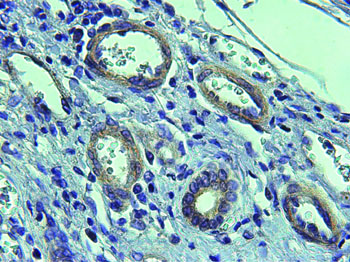Cytoplasmic Polyadenylation Element-Binding Proteins Regulate Pathologic Angiogenesis in Chronic Liver Diseas
By LabMedica International staff writers
Posted on 03 Jan 2016
A team of molecular biologists has identified a pathway that regulates the pathologic expression of VEGF (vascular endothelial growth factor), the main effector protein in the development of blood vessels, and angiogenesis in chronic liver disease.Posted on 03 Jan 2016
VEGF regulates angiogenesis, yet therapeutic strategies to disrupt VEGF signaling can interfere with necessary physiologic angiogenesis. In a search for ways to inhibit pathologic production or activities of VEGF without affecting its normal production or functions, investigators at the Institute for Research in Biomedicine (Barcelona, Spain), studied the post-transcriptional regulation of VEGF by the cytoplasmic polyadenylation element-binding proteins CPEB1 and CPEB4 during development of portal hypertension and liver disease.

Image: Pathological blood vessels (white circles) have abundant CPEB4 expression in cirrhotic tissue (Photo courtesy of the Institute for Research in Biomedicine Barcelona).
The investigators worked with liver biopsies from patients with HCV-associated cirrhosis or liver tissues removed during transplantation. They also performed experiments with male Sprague-Dawley rats and CPEB-deficient mice (C57BL6 or mixed C57BL6/129 background) and their wild-type littermates. Secondary biliary cirrhosis was induced in rats by bile duct ligation and portal hypertension was induced by partial portal vein ligation. Liver and mesenteric tissues were collected and analyzed in angiogenesis and reverse transcription PCR, and by a number of immunological tests and confocal microscopy assays. CPEB was knocked down with small interfering RNAs (siRNAs) in H5V endothelial cells, and translation of luciferase reporters constructs was assessed.
Results published in the November 25, 2015, online edition of the journal Gastroenterology revealed increased levels of CPEB1 and CPEB4 in cirrhotic liver tissues from patients, compared with control tissue, as well as in livers and mesenteries of rats and mice with cirrhosis or/and portal hypertension. Mice with liver-specific knockdown of CPEB1 or CPEB4 did not overexpress VEGF or have signs of mesenteric neovascularization, and developed less-severe forms of portal hypertension following portal vein ligation.
Regulation of CPEB4 by CPEB1 and the CPEB4 auto-amplification loop induced pathologic angiogenesis. Strategies to block the activities of CPEBs might be developed to treat chronic liver and other angiogenesis-dependent diseases.
"All current drugs that aim to prevent neovascularization are based on inhibiting VEGF or VEGF receptors, but the problem is that indiscriminate attack of this protein impairs the normal development of blood vessels, thus causing unbearable adverse effects," said Dr. Raul Méndez, research professor at the Institute for Research in Biomedicine. "The best about the study is that we demonstrate that the development of pathological blood vessels can be stopped by interfering with CPEB4 proteins while positive vascularization remains intact. The experiments in cells in vitro, in animal models, and in samples taken from patients with cirrhosis have revealed the molecular mechanisms through which the increase in CPEB4 favors the overexpression of VEGF in cirrhosis."
Related Links:
Institute for Research in Biomedicine














